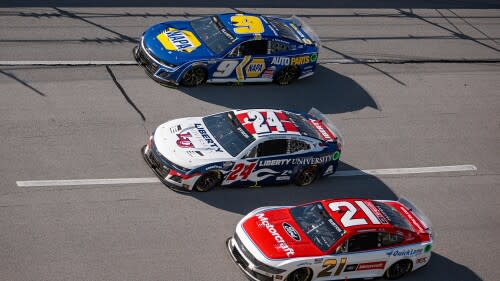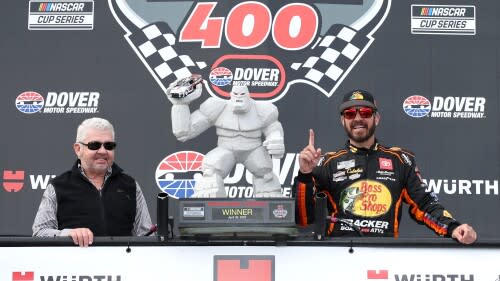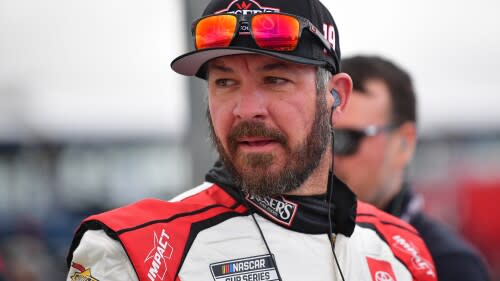Friday 5: NASCAR All-Star, Indy 500 qualifying schedules complicate Kyle Larson's plans
Kyle Larson could face some complications next month when he seeks to qualify for the Indianapolis 500 and compete in the NASCAR All-Star Race on the same weekend.
NASCAR revealed the format and schedule this week for its May 17-19 All-Star weekend at North Wilkesboro Speedway.
“We’ve been waiting for these schedules to come out,” Jeff Gordon, vice chairman at Hendrick Motorsports, told NBC Sports’ Nate Ryan this week. “Now that the All-Star schedule came out, it didn’t do us any favors, I can tell you that.”
A significant change is that the Saturday heat races (May 18) at North Wilkesboro are scheduled to begin two hours earlier than they did last year. The first heat race is scheduled for 5:20 p.m. ET and the second is scheduled for approximately 6:15 p.m. ET.
Why do those earlier start times matter?
Larson will seek to qualify for the Indianapolis 500 that day. Qualifying is scheduled from 11 a.m. - 5:50 p.m. ET. Provided there are no delays, Larson should have plenty of time to earn a spot in the field before he will have to leave for North Wilkesboro.
William Byron maintains No. 1 position in NASCAR Power Rankings after Talladega
NASCAR Cup teams have completed three drafting style races this season.
What if there is a delay at Indy or another issue that prevents Larson from qualifying before he would need to go to North Wilkesboro?
“We don’t have all the answers yet,” Gordon said. “A lot of it is between Kyle and (crew chief) Cliff (Daniels) and Rick Hendrick. Certainly I will weigh in on those things.
“We chose to do this, so that means that we want to do it the best we possibly can. Right now, I’d say the priority is that you’ve got to make the race. There’s just too much invested. Whatever it takes to make sure that that car and Kyle are starting the race for the Indy 500.”
That’s not expected to be an issue for Larson and his Arrow McLaren team. Other questions are raised should Larson be among the fastest in qualifying.
If Larson is among the top 12 qualifiers at the end of that Saturday, he’ll be eligible to take part in Sunday’s session. The 12 fastest qualifiers make another run from 2-3 p.m. ET. The top six advance to the next round. They will make another qualifying attempt that day, going for the pole between 5:15 - 5:45 p.m. ET.
If Larson is among the fastest six, he faces another issue. The All-Star Race is scheduled to begin at 8 p.m. ET at North Wilkesboro that Sunday. Larson is the defending winner.
So what happens then?
“The next priority to me is whatever is on the Cup schedule,” Gordon said. “The All-Star Race, I think Kyle is probably more leaning towards, ‘There’s a million dollars up for grabs. I won this race last year. I can win it again. I don’t care where I have to start. I’m going to be there for that.’
"Where he qualifies in the Indy 500, I don’t know if that is as critical to him as being in the Indy 500 vs. what priorities there are on the NASCAR side. We’re still working through a lot of those logistics. Now that we have the schedule, we can start creating the priorities.
“You just can’t forget at the end of the day, he’s a full-time NASCAR driver and there are races to win and a championship to win and a team that is dedicated to that. I know that Kyle gets that. He’s going to make sure that he puts the effort in to show that team where his heart is at at the end of the day.”
2. Attention to detail
This past weekend at Talladega showed the detailed work teams do away from the track and how it can impact a race.
Toyota and its teams devised a plan that saw seven of its cars pit in the final stage once they were in their fuel window to make it to the end of the race. That put those seven in position to move ahead of the field when everyone else pitted. Even with some of those Toyotas wrecking, the strategy put Tyler Reddick in position to win last weekend’s race.
NASCAR Cup drivers to watch Sunday at Dover Motor Speedway
NASCAR returns to the Monster Mile for the 106th time.
Here is an example of the detail that is examined. Knowing the plan was to pit early in the third stage, the Toyota cars arranged themselves in the back of the field in the order that they would pit.
That meant that the car leading the group was the one that had the furthest to go before reaching its pit stall (closest to pit exit). The last car in the group was in the pit stall closest to pit entrance.
That’s why the Toyotas entered pit road with Erik Jones leading. He was in pit stall 3, which was the closest to pit exit. He was followed by Bubba Wallace (pit stall 8), John Hunter Nemechek (pit stall 10), Ty Gibbs (pit stall 12), Reddick (pit stall 26), Martin Truex Jr. (pit stall 37) and Denny Hamlin (pit stall 41, the closest to pit entrance).
Why did the teams make sure they were in that order before pitting?
That allowed each driver to pull into their pit stall without having to go around another car — which would have taken more time. That could have separated the cars as they exited pit road, diminishing their speed since they would not all be in a single-file group and lessen their advantage on the rest of the field.
By being able to drive unimpeded into their pit stall, the cars saved time, exited pit road smoothly and regrouped quickly to chase the main pack.
Another key detail about pit stops was shared this week on SiriusXM NASCAR Radio’s “Late Shift” by Mike Kelley, crew chief for Ricky Stenhouse Jr.
Kelley noted that the team learned a lesson in its qualifying race at Daytona in February. Stenhouse led 15 of the first 26 laps but had to pit sooner than most other Chevrolet teams because he burned more fuel leading.
“We had led too much and pushed too hard and realized that our friends and our pals that we thought were going to work with us didn’t want to come as early as I needed to come and it put me on an island by myself,” Kelley said on SiriusXM NASCAR Radio.
“From that point forward, we put a big effort in saying, ‘Hey, let’s be the guy that saves the most.'”
Stenhouse didn’t lead a lap last weekend at Talladega and scored his first top-five finish of the season, placing fourth.
Another key detail Kelley shared on SiriusXM NASCAR Radio was how to make a fuel-only pit stop quicker.
He noted that if they need three seconds of fuel, he will tell Stenhouse to go after two seconds. Kelley explained that by the time he tells Stenhouse to go and his driver puts the car in gear to leave, three seconds of fuel will have flowed into the car before the can is disconnected.
“We know we can always call it basically a second faster than you actually need,” he said.
3. The bigger issue at Talladega, Daytona
While there was much talk about saving fuel after the Daytona 500 and last weekend’s race at Talladega, the discussion misses a bigger issue.
Drivers have talked about how challenging it is to pass at those tracks. That’s why fuel-saving is so important. More fuel saved on track means less fuel needed on pit road. Save more than others and a driver can leapfrog those cars via pit road instead of on the track.
Good news, bad news for NASCAR Cup teams ahead of Dover weekend
Dover could be the right race for Martin Truex Jr. and his Joe Gibbs Racing teammates to break their recent top-10 drought.
If passing were easier for drivers, fuel saving might not matter as much. Denny Hamlin noted on his Actions Detrimental podcast this week just how difficult it is to pass at Talladega and Daytona.
“You cannot afford to get out of line,” he said. “If you get out of line, it’s over. The reason that is is that these cars have a ton of drag.”
He noted that when a car pulls out of line, the drag on the car makes it feel as if it is “pulling a dragster parachute when you’re done with your run. The car stops immediately because it’s so heavy on drag.”
That’s made Daytona and Talladega track position races.
“At no point do you want to lose track position and that’s what has really changed over the last couple of years, especially with this Next Gen car,” Michael McDowell said of racing at a superspeedway last weekend. “It is hard to go from the back to the front. So if you are safely in the top five or eight, you really want to stay there, and a lot of times you have to drive and fight really hard all day long to stay there.”
As NASCAR looks to tires that wear more to help short track racing, series officials likely will look to aerodynamic changes with the car to help make it easier for drivers to pass. Tire changes, such as the option tire being used for next month’s All-Star Race, is not in the plans for bigger tracks.
“I think you have to be extremely cautious about what you do when you get into the superspeedways and the intermediate speedways,” Greg Stucker, Goodyear’s director of racing, said this week on “The Morning Drive” on SiriusXM NASCAR Radio, noting the speed at the bigger tracks.
4. A look ahead
After having three of the first 10 races on short tracks and another three on drafting style tracks, the NASCAR Cup Series will focus on intermediate tracks after this weekend’s race at the 1-mile Dover Motor Speedway.
The series then heads to the 1.5-mile Kansas Speedway and follows that with a visit to the 1.366-mile Darlington Raceway. After running the All-Star Race at North Wilkesboro Speedway (0.625 miles), the series holds the Coca-Cola 600 at the 1.5-mile Charlotte Motor Speedway on Memorial Day weekend.
This will be a key period for teams. After Charlotte, the series doesn’t go to another 1.5-mile track until the playoffs. Three of the 10 playoff races are at 1.5-mile tracks, including a return visit to Kansas on Sept. 29.
Also, the regular season ends this year at Darlington Raceway for the Southern 500, so the May race there will prove valuable.
5. This and that …
Ten races into this season, Chris Buescher has 245 points. He had 240 points at this time a year ago. He’s 16th in the season standings, just as he was last year. The difference is that last year he held the final playoff spot. This year, he’s the first driver outside a playoff spot.
Hendrick Motorsports and Joe Gibbs Racing have combined to claim nearly 40% of the top-10 finishes in the first 10 races of the year and 50% of the top-five finishes this year. Next is 23XI Racing, which has scored 14% of the top fives and 11% of the top 10s.
Ryan Sieg will seek to win the Dash 4 Cash $100,000 bonus for the second week in a row. He’ll race against Jesse Love, Anthony Alfredo and Riley Herbst this weekend at Dover for the prize.
Xfinity driver Sam Mayer has failed to finish eight of the last 17 races due to an accident. In the nine races he’s finished in that stretch, he has seven top 10s, including three wins.



